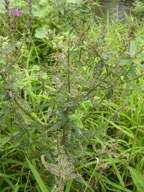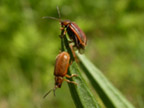|
A
Possible Solution: Galerucella Beetles
In 1992,
after extensive studies of the insect predators of purple loosestrife
in its original habitat, the USDA approved the use of two species
of Galerucella beetles as biocontrol agents. These beetles live,
eat, and breed exclusively on purple loosestrife, and prefer to
fly long distances or die rather than eat other plant species.
|
Adult beetles
spend the winter underground, hibernating among the roots
of a purple loosestrife plant. They emerge in June, and
after eating holes in the leaves of the host plant for about
a week, they mate and the females soon begin laying eggs
on the stems and leaves. One beetle can lay up to 300 eggs
over the course of 5 or 6 weeks before she dies.
Meanwhile, the
eggs begin hatching after 2 to 3 weeks, and the larvae,
which have voracious appetites, begin eating the flower
buds and growing tips of the plant. This behavior, called
"tip feeding," causes extensive damage, leaving
the plant stunted and brown. After several weeks of eating,
the larvae are ready to pupate. They crawl down the stem
and bury themselves in the soil.
|
|
 |
|
|
|
|
from:
Alyson Loos and David Ragsdale, "Biological Control of
Purple Loosestrife: A Guide for Rearing Leaf-feeding Beetles" |
|
In another
2 to 3 weeks the insects emerge as adults. If the plant they are
on is badly damaged, they take flight in search of other loosestrife
plants on which to dine. They do not lay eggs at this time; they
eat for several weeks, and return to the soil in late August to
begin their long winter's sleep, completing the cycle.
|
Eggs
Larvae Adult
Galerucella Beetles
|
|
Above
photos from Agriculture and Agri-Food Canada Archives, Agriculture
and Agri-Food Canada
|
Galerucella beetles were released
in the late 1990's at both the Great Meadows National Wildlife Refuge
in Concord, MA, and the Parker River National Wildlife Refuge in
Newburyport, MA. The resulting decrease in loosestrife vigor allowed
the wetland species that had originally been abundant to regain
their dominance.
In 2000 the
Massachusetts Office of Coastal Zone Management (MOCZM) developed
a Purple Loosestrife Biocontrol Project as part of its Wetlands
Restoration Program. The Project has overseen the release of beetles
at 10 other sites in Massachusetts, all of which are being monitored
for purple loosestrife damage.
| In
the 2006 photos on the right, of purple loosestrife plants
at Fresh Pond Reservation, bullethole patterns indicate feeding
by adult Galerucella beetles, and severe damage indicates
feeding by larvae. Beetles from a biocontrol program as far
as 10 miles away might have flown to Fresh Pond in search
of food. |
|
 |
|
 |
|
|





